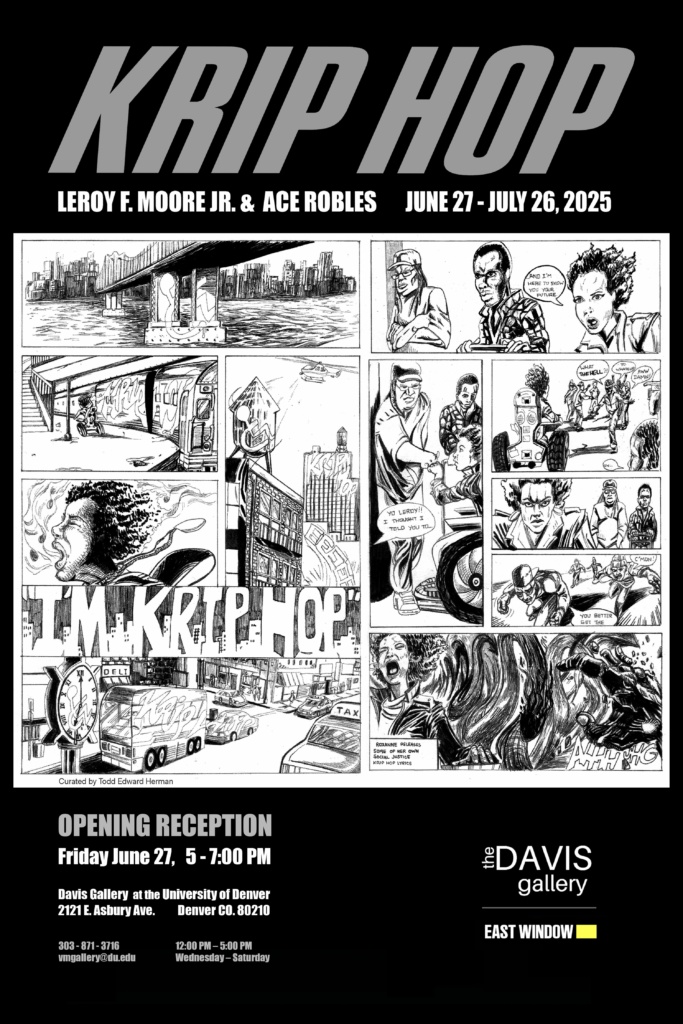Welcome to the Davis Gallery!
The University of Denver’s newest exhibition space is a student-powered initiative for community creative projects located in the lobby of Shwayder Art Building. The Davis Gallery was founded in the name of Helen Davis, a generous supporter of the arts, with additional funding from LinkAGES. The creation of the Davis Gallery was spearheaded by Roddy MacInnes, Professor of Photography at the School of Art and Art History, who now serves as the faculty supervisor of the space. Constructed during the 2021-2022 academic year, the space first opened to the public in January 2022.
The Davis Gallery is open to all DU community members. Each academic year, two graduate students are selected to coordinate, install, and assist with curating a calendar of rotating exhibitions. These two students are referred to as the Programming and Engagement Coordinators. Exhibitions are submitted online, and then selected by the Davis Gallery committee. Though housed in the Schwayder Art Building, dedicated to the study and practice of the visual arts, the Davis Gallery is open to all DU campus. The Davis Gallery, along with the Vicki Myhren Gallery, is intended as an appendage to the School of Art and Art History’s educational mission. The Davis Gallery is specifically oriented towards important student professional development, cross-disciplinary collaborations, student community collaborations, and experimental exhibitions. By providing a safe space to show works and ideas, the gallery hopes to facilitate exciting conversations and opportunities for the DU campus community and beyond.
Now on View:
Krip-Hop
Leroy F. Moore Jr. and Ace Robles
Curated by Todd Herman
On view in the Davis Gallery, June 27 through July 26

Our Students
Annie Drysdale

Annie Drysdale is an Art History and Museum Studies graduate student and acts as the Exhibitions Manager for the Davis Community Art Gallery. Aside from being a student, Annie considers herself to be an accountable ally and activist. Her graduate thesis and community engagement work center around Indigenous sovereignty. In addition to her coursework in January of 2022, Annie co-created an organization called Storytellers of the Ancestral Red Road (SOAR). SOAR is an AiS grant-funded community collective of Indigenous knowledge keepers and allies who promote cultural wisdom in educational settings, using creative expression as the driving force of inspiration for community healing. Her graduate thesis work is focused on the responsible integration of Indigenous Research Methods into art historical and museology practices. Annie is proud that her thesis research is being conducted in direct collaboration with Diné artist Susan Hudson, who is the first Indigenous storyteller quilter in the United States. For Annie, the path forward from her degree is uncertain, but wherever it leads, she knows she will bring the power of positive change with her.
Joy Saliu

Joy Saliu is a first-year art history graduate student with a concentration in museum studies. She works as a graduate gallery assistant at the Davis Gallery. She has lived in Colorado for 7 years and received her bachelor degree in Asian Studies from Metropolitan State University in Denver in 2023. Joy is interested in Asian and African arts and cultures, specifically Western African and South and Southeast Asian art. She is planning on doing her thesis research on contemporary HMong art and collective memory. After graduating, Joy hopes to work in collections and museum education field.
